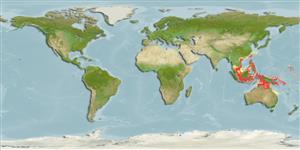Common names from other countries
>
Eupercaria/misc (Various families in series Eupercaria) >
Labridae (Wrasses)
Etymology: Leptojulis: Greek, leptos = thin + Greek, ioulis, a fish dealing with genera Coris or Thalassoma (Ref. 45335); urostigma: From a Greek word meaning 'tail spot', referring to the large balck spot on the base of the caudal fin, its most diagnostic feature..
More on author: Randall.
Environment: milieu / climate zone / depth range / distribution range
Ecología
marino demersal; rango de profundidad 7 - 100 m (Ref. 12420). Tropical
Distribución
Países | Áreas FAO | Ecosistemas | Ocurrencias, apariciones | Point map | Introducciones | Faunafri
Western Pacific: Taiwan, Philippines, Indonesia, and Papua New Guinea.
Tamaño / Peso / Age
Maturity: Lm ? range ? - ? cm
Max length : 11.0 cm TL macho / no sexado; (Ref. 48636)
Occurs solitary or in small groups (Ref. 90102) on muddy bottoms, often deep in front of river mouths where land debris is scattered over the bottom; sometimes takes refuge in the mud burrows of other animals. Adults were all seen in about 30 m and usually swim fast near the bottom (Ref. 48636). Feeds on benthic animals (polychaete worms, crustaceans, also small fish) (Ref. 12420). Minimum depth of 7 m from Ref. 90102.
Life cycle and mating behavior
Maturities | Reproducción | Spawnings | Egg(s) | Fecundities | Larva
Oviparous, distinct pairing during breeding (Ref. 205).
Randall, J.E., 1996. Second revision of the labrid fish genus Leptojulis, with descriptions of two new species. Indo-Pac. Fish. (24):20 p. (Ref. 12420)
IUCN Red List Status (Ref. 130435)
CITES (Ref. 128078)
Not Evaluated
Threat to humans
Harmless
Human uses
Herramientas
Special reports
Download XML
Fuentes de Internet
Estimates based on models
Preferred temperature (Ref.
115969): 26.5 - 29, mean 28 (based on 552 cells).
Phylogenetic diversity index (Ref.
82804): PD
50 = 0.5312 [Uniqueness, from 0.5 = low to 2.0 = high].
Bayesian length-weight: a=0.00501 (0.00207 - 0.01214), b=3.15 (2.94 - 3.36), in cm Total Length, based on LWR estimates for this (Sub)family-body shape (Ref.
93245).
Nivel trófico (Ref.
69278): 3.7 ±0.54 se; based on food items.
Resiliencia (Ref.
120179): Alto, población duplicada en un tiempo mínimo inferior a 15 meses (Preliminary K or Fecundity.).
Fishing Vulnerability (Ref.
59153): Low vulnerability (10 of 100).
